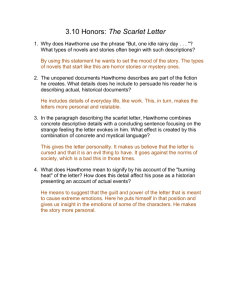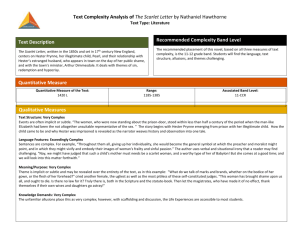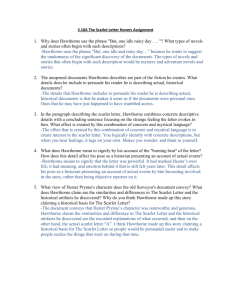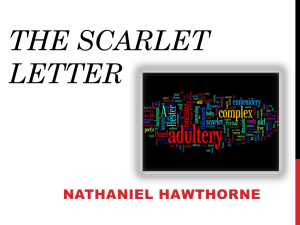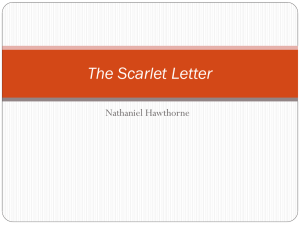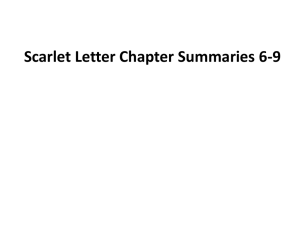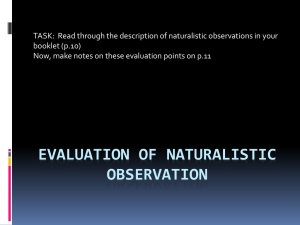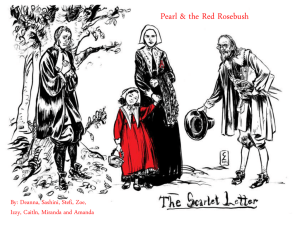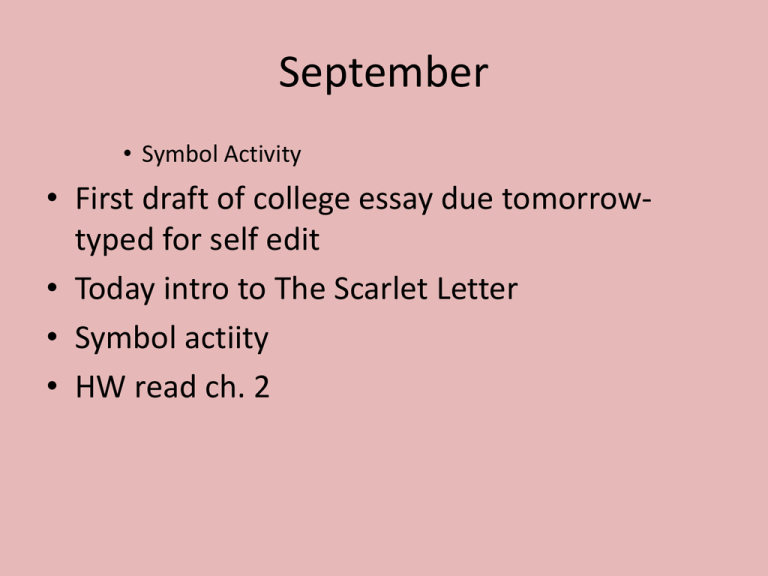
September
• Symbol Activity
• First draft of college essay due tomorrowtyped for self edit
• Today intro to The Scarlet Letter
• Symbol actiity
• HW read ch. 2
A preview
• http://www.youtube.com/watch?v=NR3BVN8
ofk8
The Dude
Why do we care?
• Hester Prynne is the first true heroine of
American Literature.
• Not just a sex symbol!
– Whole person
– Mother
– Woman
– Sinner
– Lover and more!
Symbolic imagination
• The Romantics believed that symbols
(especially those relating to nature) allowed
authors to express the inexpressible—or the
infinite.
• The Scarlet Letter is considered the first
symbolic novel in America.
• Jot down the first ideas that come into your
mind.
• Free associate
• In general, what ideas do these objects
represent or symbolize to you?
What do these roses symbolize?
Pearl
Discuss images
• How might they support both stated and
unstated ideas regarding the Puritans, their
way of life and their idea of law?
Focus Question
1 How do the symbols help us understand
Hawthorne’s attitude toward the Puritans in
Chapter 1. Find examples
2 And pay attention to the SYMBOLS.
• “Everything in The Scarlet Letter is a symbol”
– Vienna Larch former HL2 student
Ch 1
• Read out loud
• Pay attention to symbols
colors
• Sad-colored, grey,
• Connotations?
– Drab
– Little joy
– plain
Prison door
• Old, rusted, yet strong
• “iron clamped oaken door”
• What does this say about the Puritans?
– Harsh enforcement of the laws and the inability to
break free of them
– Metaphor for the authority of the regime which
does not tolerate deviance
Rosebush
How does the reference to Anne Hutchinson
reveal Hawthorne’s attitude toward Puritans?
Springing, perhaps from her footsteps….
perhaps hope?
Ann
Hutchingson
Anne Hutchinson
• Banished from Mass. Bay Colony in 1638 for
conducting religious meetings in her home at
which “erroneous opinions” were taught.
• Puritans believed that the Bible was source of
God’s truth and only clergy could interpret
scripture.
• Hutchinson and her followers believed people
could communicate directly with God
Banished from Boston
• Anne and her husband, William, found refuge
in Roger Williams colonly in Rhode Island.
• After husband dies she moved to long island.
• In 1643 she and all her servants and children
save one were killed by Indians, an event
regarded by some in Massachusetts as a
manifestation of divine judgment.
What else do you notice in the
opening that interests you?
Opening ch. 2
• How does he create suspense?
– Who is going to emerge?
• What is the difference between the Puritan
audience and modern readers?
– Think of judgment
– The Puritans have judged her already
– We haven’t
Close Reading
1. What type of person is Hester Prynn?
Find adjectives, actions, and descriptions of her
character.
2.How does the description of the reinforce our
perception of Hester?
3. How does the town-beadle’s aspect represent
the Puritanic code of law?
Ch. 2 Market Place
• Why do the women pass such harsh judgment
on Hester?
• Any questions on STUDY GUIDE?
Theme of chapter 2?
• Sin and Punishment
Chapter lll
• Character Description:
Ch. 3: The Recognition
Theme: Appearance/Reality
• .
Appearance/reality
• How does Hawthorne introduce Chillingworth?
• How is he described in the first few pages?
1 Find Snippets of description. A word or phrase or
sentence that captures the essence of character.
2. Line or two of dialogue that reveals more than surface
appearance
3. Romantic Symbol of nature or physiognomy that
expresses character
4. Assign letter for his main trait
Group 1 first few paragraphs (44-45 to “what has brought
her to yonder scaffold?”)
Group 2: “ Truly, friend; and methinks it must….Hearken
unto me, (top of 47)
Appearance/Reality
• How does He depict Dimmesdale and Chillinworth?
1 Find Snippets of description. A word or phrase or
sentence that captures the essence of character.
2. Line or two of dialogue that might reveal more
than surface appearance
3. Romantic Symbol of nature or physiognomy that
expresses character
4. Assign letter for his main trait and defend this
decision with text support.
Chapter 4: The Interview
Theme: Natural law vs Civil law
• What might natural law be in this context?
• What then, is civil (human) law?
• Which law did Hester and Chillingworth violate?
• Why does Hester agree not to reveal Chillingworth as
her husband?
• Interpret the last line of this chapter. What might if
foreshadow?
Review our snippets and letter
• Is our first impression of him accurate?
• What would you add?
What does the juxtaposition of the prison
door and rosebush represent?
• Human law, represented by the prison door, and
natural law, represented by the rosebush, often
contradict each other.
• Romantics believed in nature’s sympathy toward man
• Who does nature sympathize with?
– Who was in the prison (historically?)
– In novel?
– How are they related?
• Chapter 5: Study guide
– What is the point that Hawthorne makes about an
individual’s ability to separate one’s self from
one’s wrong doing?
– How does her sin connect her with others?
Chapter 6-7: Journals:
• Write down
• Chapter 8 we will act out. I’ll assign roles
tomorrow.
Chapter 5
• What is the point that Hawthorne makes
about an individual’s ability to separate one’s
self from one’s wrong doing?
• How does her sin connect her with others?
Pearl? The Governor’s Hall
Ch. 7
• Comments regarding Pearl?
• descriptions of Pearl?
• What images are associated with her?
• There was fire in her and throughout her
• Pearl’s beauty made her the very brightest
little jet of flame that ever danced upon the
earth.
Governor’s Mansion
• How is the garden a symbol?P. 72…
• Cabbages frew in plain sight; and a pumpkin
deposited one of its gigantic products directly
beneath the hall windows as if to warn the
Governor that this great lump of vegetable gold
was as rich an ornament as New England earth
would offer him. There were a few rose=bushes
however…
• And Pear, of course wants one…
Ch. 8. p 74 “What have we here?
•
•
•
•
•
•
•
•
Hester
Pearl
Gov. Bellingham
Mr. Wilson
Dimmesdale
Chillingworth
Mistress Hibbins
Narrator
Ch 8 Pay to ATTENTION:
• What is going on?
• Presentation and role of character(s)
• Relationships
• Symbols and motifs
• Themes
• Use of language
• Different attitudes
What strikes you as significant?
• What is ironic about the governor and his
surroundings?
• What information do we learn from dialogue?
• Words used today?
• Attitude of men toward women?
• Hester’s own attitude regarding her ability to
be a good mother.
Agenda
• Meet in groups to share ideas (5min)
• Present sections of 9-10 to class. (use text
support) (5min)
• Homework: Read 11-12 . After you have read,
look at your assigned passage. Read the
essential question (EQ) and mark up your
passage. Write your commentary on the
back. Leave insight box empty for now.
Homework for Friday
• Read ch. 13- 14
• Journal:
• Write down Two passages from each chapter
and why they are significant.
Chapter 11
• What does Chillingworth see at the end of ch.
10?
• As a result of this, what does he resolve to do?
• Find a passage that reveals the irony of
Dimmesdale’s attempt to confess to his
congregation. P. 95
• P. 97: what does Hawthorne say about living a
false life?
• 1. Identify the scene
• 2 What do you think of
Matteson’s portrayal
of the characters?
• 3. What is each
character looking at?
How might this signify
what is on the
character’s mind?
• 4. How does light and
dark colors affect the
overall mood?
• 5. Has the artist
accomplished an
effective portrayal of
this scene? Why or
why not?
Ch. 12 Activity
• Find 3 people with the same color paper. And
Discuss the EQ. Write a key insights in the box.
• Make sure you are supporting statements with
textual references.
• Move to a new group with all different colors.
• Each person will explain the significance of
their passage
Hawthorne
• Wrote The Scarlet Letter between the fall of
1849 when his mother died and Feb 3, 1850
when he “repeatedly” read the conclusion to
his wife.
• (FIVE MONTHS!)
Interesting fact: Used to be a Hathorne
• His great-great- grandfather was a judge at the
Salem witch trials.
• Added the W to his name to avoid affiliation.
• But was still afflicted with shame, nonetheless
The novel is considered a Historical
Romance
• Written during the transcendentalism
movement (1836-60)
• Emerson, Thoreau, Margaret Fuller,
• TC Stressed the romantic tenets of mysticism,
idealism, and individualism.
• God not harsh authority, but essential part of
the natural world and the individual.
I become a transparent eyeball, I am nothing; I see all;
the currents of the Universal Being circulate through
me; I am part and parcel of God.” – Ralph Waldo
Emerson
Hawthorne not a believer in TC
• Poked fun at his buddies, though he lived for a
while at Brook farm (experimental
community)
Hawthorne
“Hawthorne believed that beneath all of the
societal influences in a person's life there could
be found “the truth of the human heart” and
through symbolism and intense character
development, he aimed to shine through to the
reader that inner heart. For this reason alone
and the many others that exist, Nathaniel
Hawthorne was a great Romantic author.”
-Montana Academy Tripod
Romanticism
• Combined logic and feeling
• “Reconciliation of opposites” is central idea of
the Romantics.
• Role of Nature;
– Healing power
– Source of subject and image
– Refuge from artificial constructs of civilization
– Viewed as organic
A few things..
• Hawthorne explores the depths of our
common nature and the truth of our own
hearts.
• Interested in the problem of evil and the
nature of sin.
Biblical definition of Sin
• A transgression of a religious or moral law,
especially when deliberate.
• Sin is any deliberate action, attitude, or
thought that goes against God.
Visible acts: murder, adultery, or theft. But also…
Sins of the heart: (Invisible) pride, envy, jealousy,
thoughts of revenge, etc.

